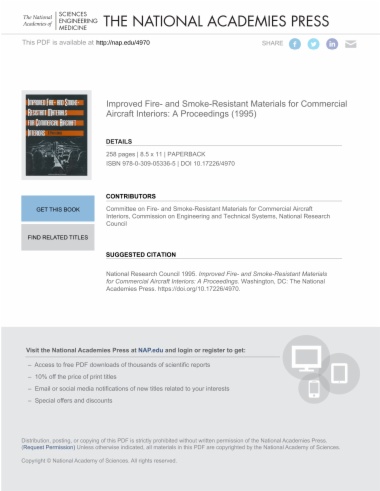This book describes the Conference on Fire and Smoke-Resistant Materials held at the National Academy of Sciences on November 8-10, 1994. The purpose of this conference was to identify trends in aircraft fire safety and promising research directions for the Federal Aviation Administration's program in smoke and fire resistant materials. This proceedings contains 15 papers presented by distinguished speakers and summaries of the workshop sessions concerning toxicity issues, fire performance parameters, drivers for materials development, and new materials technology.
- Cover
- Front Matter
- Part I - Invited Papers
- Chapter 1. Federal Aviation Administration Fire-Safety Mission
- Chapter 2. Airplane Accidents and Fires
- Chapter 3. Heat Exposure and Burning Behavior of Cabin Materials . . .
- Chapter 4. Fundamental Fire Properties of Combustible Materials
- Chapter 5. Fire Tests and Hazard Evaluation
- Chapter 6. Fire Properties of Materials
- Chapter 7. Fire-Screening Results of Polymers and Composites
- Chapter 8. Fire Properties of Future Material Candidates
- Chapter 9. Meeting FR Goals Using Polymer Additive Systems
- Chapter 10. An Overview of Inorganic and Organometallic Polymers
- Chapter 11. Flame-Retarding Wool Textile Materials and the Evaluation of Thermally Stable...
- Chapter 12. Smoke Toxicity
- Chapter 13. In-Service Performance Criteria for Aircraft Interiors
- Chapter 14. Design of Aircraft Interior
- Chapter 15. Processing and Manufacturing of Interior Components
- Part II - Workshop Summary
- Session I: Toxicity
- Session II: Fire Performance Parameters
- Session III: Drivers for Materials Development
- Session IV: New Materials Technology
- Appendix A: Conference Program
- Appendix B: Conference Participants and Speakers

